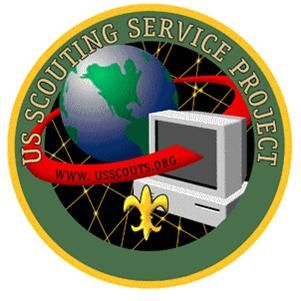General Information
The Guide to Advancement - 2017 and 2018 Boy Scout Requirements are the official Boy Scouts of America sources on Boy Scout advancement procedures.
When there is a conflict between two published lists of requirements, such as Boy Scout Requirements (BSA Publication No. 33216) and a Merit Badge pamphlet or the Boy Scout Handbook, the requirements book should normally be considered to be the controlling document, until a newer edition of Boy Scout Requirements is issued. However, the following excerpt from the Guide to Advancement, 2017 explains what to do when merit badge requirements change:
7.0.4.3 What to Do When Requirements Change
The current annual edition of Boy Scout Requirements lists the official merit badge requirements. Once new or revised merit badge requirements appear in this publication, which is released each January, any Scout just beginning work on a merit badge must use the requirements as stated there.
If changes to merit badge requirements are introduced in a revised merit badge pamphlet after the January release of the Boy Scout Requirements book, then the Scout has until the following January 1 to decide what to do. He may continue—or begin work—using the old merit badge requirements and the old pamphlet; or he may switch to—or begin work—using the new requirements and the new pamphlet. Unless it is otherwise stated in the merit badge pamphlet, Boy Scout Requirements, or official communications from the National Council, if a Scout chooses to use the old merit badge requirements and pamphlet, he may continue using them until he has completed the badge.
There is no time limit between starting and completing a badge, although a counselor may determine so much time has passed since any effort took place that the new requirements must be used.
In addition, the following information is included on the inside front cover of the 2018 edition of Boy Scout Requirements:
The requirements listed in this Boy Scout Requirements book for rank advancement, Eagle Palms, and merit badges are the official requirements of the Boy Scouts of America and are effective Jan. 1, 2018, through Dec. 31, 2018. However, the requirements on the following pages might not match those in the Boy Scout Handbook and the merit badge pamphlets, because this publication is updated only on an annual basis. The most current and any updated merit badge requirements can be found at www.scouting.org/meritbadges.
When new or revised merit badge requirements appear in this Boy Scout Requirements book, any Scout beginning work on a merit badge must use the requirements as stated therein. However, if changes to merit badge requirements are introduced in a revised merit badge pamphlet or at www.scouting.org/meritbadges throughout the year, then the Scout has through the end of the current calendar year to decide which set of requirements to use.
Once a Scout begins work, he may continue using the requirements he started with until completion of the badge. Alternatively, he may choose to switch to the revised requirements. Sometimes, however—especially for more significant changes—the Boy Scout Handbook, the Boy Scout Requirements book, www.scouting.org/meritbadges, or official communications from the National Council may set forth a different procedure that must be used. The National Council may establish a new date for when use of the existing requirements must cease.
There is no time limit between starting and completing a badge, although a counselor may determine so much time has passed since any effort took place that the new requirements must be used.
No council, district, unit, or individual has the authority to add to, or to subtract from, any advancement or merit badge requirements. For more detailed information, see the Guide to Advancement, which is available online at www.scouting.org/Home/GuideToAdvancement.aspx.
During 2015, after multi-year period of review, BSA proposed changes, to the requirements for the Scout badge, which is now officially designated a "rank", as well as to the requirements for all of the ranks from Tenderfoot to Eagle, and for Eagle Palms. These changes, in draft form, were announced during 2015 and changes to some of the draft requirements were made at various times during the year. A new edition of the Boy Scout Handbook was issued in January, 2016 and a new edition of Boy Scout Requirements was issued in February, 2016, containing the final, approved, requirements. During 2016, which served as a transition period, Scouts could advance to the next rank using the previous requirements, Since January 1, 2017, however, all Scouts must use the current requirements for advancement.
Information in the 2018 Boy Scout Requirements book
The list of changes on the inside front cover of the new edition of Boy Scout Requirements identifies changes to the requirements for two ranks (Second Class and First Class), which became effective on August 1, 2017, along with changes to 27 merit badges, the deletion of one "Special Opportunity" (the Denali Award) which was available only to Varsity Scouts, and the addition of one new "Special Opportunity".
In addition to the listed changes, we have identified a series of other changes, as follows:
- As a consequence of the announced ending of the Varsity Scout program, some changes were made to the requirements and notes for each Boy Scout rank and Eagle Palms, and for some of the "Special Opportunities".
- Due to the announced separation of Sea Scouting from Venturing, changes were made to the lists of positions in requirement 5 for the Star, Life, and Eagle ranks in 2017, but were not noted at that time.
- After BSA announced some changes to the requirements for Eagle Palms which became effective on August 1, 2017, they made some minor wording changes in October, and again in the 2018 Boy Scout Requirements book.
- Two other merit badges and some other "Special Opportunities" also have had changes.
- Information on the Complete Angler recognition which became available in 2014, and on the Whitewater Rafting BSA award, which was made available starting with the 2017 National Jamboree, has been included for the first time.
While not identified in the list of changes on the inside front cover (IFC), each of these other changes appears in the text of the 2018 edition of the Boy Scout Requirements book, and is shown in this document.
The "Merit Badge Library" listing on the inside back cover, which lists all merit badge pamphlets with their most recent publication dates does not list any new pamphlet dates since the 2017 edition. Click here for our list of all of the merit badge pamphlets, which identifies the most recent edition of each, whether the old pamphlet can still be used, and when the requirements were last revised. Our list also identifies which merit badge pamphlets have been announced as being available as Kindle books, through Amazon.com, and/or as Digital Interactive merit badge pamphlets through Scoutshop.org. However, although the Kindle versions are still available, the digital interactive versions are currently (as of January 2018) not available, while they are undergoing some production platform changes.
We have also included in this report a list of 8 merit badges where the wording of the requirements in the Boy Scout Requirements book differs from the wording in the current merit badge pamphlets.
Although BSA has previously announced plans to release a few more new merit badges in the coming years, including Multi-Media, Computer Aided Design, and Advanced Computing, no current schedule has been announced as to if or when those badges may be available.
Index of Changes
* Ranks, badges, and awards
that were not included in the listing
on the inside front cover of the 2018 edition of Boy Scout Requirements.
Changes to Rank Requirements
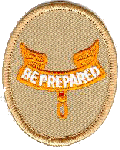 Scout
Scout
Although there were no changes to the text of the requirements, the introductory note was revised, the note regarding Varsity Scouts was deleted, and a note regarding Alternative requirements was added. These changes were not noted in the listing on the inside front cover of the 2018 Boy Scout Requirements book. The changes are as follows:
All requirements for Scout rank must be completed as a member of a troop or as a Lone Scout. If you already completed these requirements as part of the Webelos Scouting Adventure, simply demonstrate your knowledge or skills to your Scoutmaster or other designated leader after joining the troop.
For Varsity Scouts working on Boy Scout requirements, replace "troop" with "team", and "Scoutmaster" with "Varsity Scout Coach."
Alternative requirements for the Scout rank are available for Scouts with physical or mental disabilities if they meet the criteria listed in the Boy Scout Requirements book.
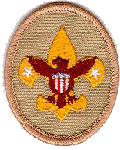 Tenderfoot
Tenderfoot
Although there were no changes to the text of the requirements, the note regarding Varsity Scouts was deleted, and the note regarding Alternative requirements was revised. These changes were not noted in the listing on the inside front cover of the 2018 Boy Scout Requirements book. The changes are as follows:
For Varsity Scouts working on Boy Scout requirements, replace "troop" with "team", and "Scoutmaster" with "Varsity Scout Coach."
Alternative Alternate Requirements for the Tenderfoot rank are available for Scouts with physical or mental disabilities if they meet the criteria listed in the Boy Scout Requirements book.
 Second
Class
Second
Class
On August 1, 2017, a new footnote 3 was added to requirements 5b and 5c. On January 1, 2018, minor changes were made to the wording of requirements 1b, 2d, 2f, 2 g, and 7a. The note regarding Varsity Scouts was deleted, the note regarding Alternative requirements was revised, and footnote 3 was revised. The changes are as follows:
- Explain the principles of Leave No Trace, and tell how you practiced them while on a campout or outing. This outing must be different from the one used for Tenderfoot requirement 1c.
- Explain when it is appropriate to use a lightweight stove and when it is appropriate to use a propane stove. Set up a lightweight stove or propane stove. Light the stove, unless Unless prohibited by local fire restrictions, light the stove. Describe the safety procedures for using these types of stoves.
- Demonstrate how to tie tying the sheet bend knot. Describe a situation in which you would use this knot.
- Demonstrate how to tie tying the bowline knot. Describe a situation in which you would use this knot.
- Using a compass and a map together, take a five 5-mile hike (or 10 miles by bike) approved by your adult leader and your parent or guardian.2
- Demonstrate your ability to pass the BSA beginner test. Jump feetfirst into water over your head in depth, level off and swim 25 feet on the surface, stop, turn sharply, resume swimming, then return to your starting place.3
- Demonstrate water rescue methods by reaching with your arm or leg, by reaching with a suitable object, and by throwing lines and objects.3
- After competing Tenderfoot requirement 6c, be physically active at least 30 minutes a each day for five days a week for four weeks. Keep track of your activities.
For Varsity Scouts working on Boy Scout requirements, replace "troop" with "team” and "Scoutmaster" with "Varsity Scout Coach."
Alternative Alternate Requirements for the Second Class rank are available for Scouts with physical or mental disabilities if they meet the criteria listed in the Boy Scout Requirements book.
3Under certain exceptional conditions, where the climate keeps the outdoor water temperature below safe levels the year-round, or where there are no suitably safe and accessible places (outdoors or indoors) within a reasonable traveling distance to swim at any time during the year, the council Scout executive and advancement committee may, on an individual Scout basis, authorize an alternative requirement for requirements 5b and 5c. The local council may establish appropriate procedures for submitting and processing these types of requests. All the other requirements, none of which necessitate entry in the water or entry in a watercraft on the water, must be completed as written.
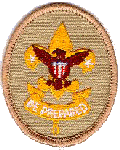 First
Class
First
Class
On August 1, 2017, changes were made to requirement 1a, footnote 3 was renumbered as 4 and a new footnote 5 was added to requirements 6a and 6e. On January 1, 2018, requirement 8b was revised, the note regarding Varsity Scouts was deleted, the note regarding Alternative requirements was revised, and footnote 5 was revised. The changes are as follows:
- Since joining Boy Scouts, participate in 10 separate troop/patrol activities, at least six of which must be held outdoors. Of the outdoor activities, at least three must include overnight camping. These 10 activities do not include troop or patrol meetings. On at least five of the six campouts, spend the night in a tent that you pitch or other structure that you help erect , . (such as a lean-to, snow cave, or tepee.)
- Successfully complete the BSA swimmer test.3 4 and 5
- With a helper and a practice victim, show a line rescue both as tender and rescuer. (The practice victim should be approximately 30 feet from shore in deep water.)5
- Share your challenges and successes in completing First Class requirement 8a. Set a goal for continuing to include physical activity as part of your daily life and develop a plan for doing so.
For Varsity Scouts working on Boy Scout requirements, replace "troop" with "team" and "Scoutmaster" with "Varsity Scout Coach."
Alternative Alternate Requirements for the First Class rank are available for Scouts with physical or mental disabilities if they meet the criteria listed in the Boy Scout Requirements book.
3 4 See the Swimming merit badge requirements for details about the BSA Swimmer test.
5 Under certain exceptional conditions, where the climate keeps the outdoor water temperature below safe levels the year-round, or where there are no suitably safe and accessible places (outdoors or indoors) within a reasonable traveling distance to swim at any time during the year, the council Scout executive and advancement committee may, on an individual Scout basis, authorize an alternative for requirements 6a and 6e. The local council may establish appropriate procedures for submitting and processing these types of requests. All the other requirements, none of which necessitate entry in the water or entry in a watercraft on the water, must be completed as written.
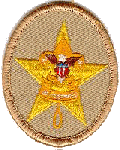 Star
Star
Although it was not announced at that time, Requirement 5 was changed in 2017 by splitting and revising the list of Venturing and Sea Scouting positions.
Requirement 5 was revised by removing the list of Varsity Scout positions. The note regarding Varsity Scouts was deleted and footnotes 4, 5, and 6, were renumbered as 6, 7, and 8, and footnote 8 was revised. These changes were not noted in the listing on the inside front cover of the 2018 Boy Scout Requirements book. The changes are as follows:
- While a First Class Scout, serve actively in your troop for four months in one or more of the following positions of responsibility (or carry out a Scoutmaster assigned leadership project to help the troop):
Boy Scout troop.
- Patrol leader,
- assistant senior patrol leader,
- senior patrol leader,
- troop guide,
- Order of the Arrow troop representative,
- den chief,
- scribe,
- librarian,
- historian,
- quartermaster,
- bugler,
- junior assistant Scoutmaster,
- chaplain aide,
- instructor,
- webmaster, or
- outdoor ethics guide 4 6
Varsity Scout team.
- Captain,
- co-captain,
- program manager,
- squad leader,
- team secretary,
- Order of the Arrow team representative,
- librarian,
- historian,
- quartermaster,
- chaplain aide,
- instructor,
- den chief,
- webmaster, or
- outdoor ethics guide
Venturing crew / Sea Scout ship.
- President,
- vice president,
- secretary,
- treasurer,
- den chief,
- quartermaster,
- historian,
- guide,
- quartermaster,
- chaplain aide, or
- outdoor ethics guide
- boatswain,
- boatswain's mate,
- yeoman,
- purser,
- storekeeper, or
- webmaster,
Sea Scout ship.
- boatswain,
- boatswain's mate,
- purser,
- yeoman,
- crew leader,
- media specialist,
- specialist,
- den chief, or
- chaplain aide.
Lone Scout.
Leadership responsibility in your school, religious organization, club, or elsewhere in your community.- With your parent or guardian, complete the exercises in the pamphlet "How to Protect Your Children from Child Abuse: A Parents Guide" and earn the Cyber Chip Award for your grade. 5 7
- Successfully complete your board of review for the Star rank. 6 8
For Varsity Scouts working on Boy Scout requirements, replace "troop" with "team" and "Scoutmaster" with "Varsity Scout Coach."
For Venturers working on Boy Scout requirements, replace "troop" with "crew" and "Scoutmaster" with "Crew Advisor"
For Sea Scouts working on Boy Scout requirements, replace "troop" with "ship" and for "Scoutmaster" with "Skipper".4 6 Assistant patrol leader is not an approved position of responsibility for the Star, Life, or Eagle rank.
5 7 If your family does not have internet access at home AND you do not have ready internet access at school or another public place or via a mobile device, the Cyber Chip portion of the requirement may be waived by your Scoutmaster in consultation with your parent or guardian.
6 8 If the board of review does not approve the Scout's advancement, the decision may be appealed in accordance with Guide to Advancement topic 8.0.4.0.
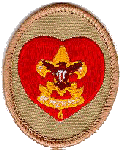 Life
Life
Although it was not announced at that time, Requirement 5 was changed in 2017 by splitting and revising the list of Venturing and Sea Scouting positions.
Requirement 5 was revised by removing the list of Varsity Scout positions. The note regarding Varsity Scouts was deleted and footnotes 7 and 8, were renumbered as 9 and 10. These changes were not noted in the listing on the inside front cover of the 2018 Boy Scout Requirements book. The changes are as follows:
- While a Star Scout, serve actively in your troop for six months in one or more of the following positions of responsibility (or carry out a unit leader-assigned leadership project to help the troop):
Boy Scout troop.
- Patrol leader,
- assistant senior patrol leader,
- senior patrol leader,
- troop guide,
- Order of the Arrow troop representative,
- den chief,
- scribe,
- librarian,
- historian,
- quartermaster,
- bugler,
- junior assistant Scoutmaster,
- chaplain aide,
- instructor,
- webmaster, or
- outdoor ethics guide 7 9
Varsity Scout team.
- Captain,
- co-captain,
- program manager,
- squad leader,
- team secretary,
- Order of the Arrow team representative,
- librarian,
- historian,
- quartermaster,
- chaplain aide,
- instructor,
- den chief,
- webmaster, or
- outdoor ethics guide
Venturing crew / Sea Scout ship.
- President,
- vice president,
- secretary,
- treasurer,
- den chief,
- quartermaster,
- historian,
- guide,
- quartermaster,
- chaplain aide, or
- outdoor ethics guide
- boatswain,
- boatswain's mate,
- yeoman,
- purser,
- storekeeper, or
- webmaster,
Sea Scout ship.
- boatswain,
- boatswain's mate,
- purser,
- yeoman,
- crew leader,
- media specialist,
- specialist,
- den chief, or
- chaplain aide.
Lone Scout.
Leadership responsibility in your school, religious organization, club, or elsewhere in your community.- Successfully complete your board of review for the Life rank. 8 10
For Varsity Scouts working on Boy Scout requirements, replace "troop" with "team" and "Scoutmaster" with "Varsity Scout Coach."
For Venturers working on Boy Scout requirements, replace "troop" with "crew" and "Scoutmaster" with "Crew Advisor."
For Sea Scouts working on Boy Scout requirements, replace "troop" with "ship" and "Scoutmaster" with "Skipper."7 9 Assistant patrol leader is not an approved position of responsibility for the Star, Life, or Eagle rank.
8 10 If the board of review does not approve the Scout's advancement, the decision may be appealed in accordance with Guide to Advancement, topic 8.0.4.0.
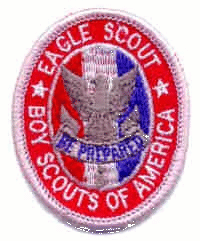 Eagle
Scout
Eagle
Scout
Although it was not announced at that time, Requirement 5 was changed in 2017 by splitting and revising the list of Venturing and Sea Scouting positions, and a change was made to the wording of footnote 9.
Requirement 5 was revised by removing the list of Varsity Scout positions. The note regarding Varsity Scouts was deleted, footnotes 9, 10, and 11, were renumbered as 11, 12, and 13, and footnote 13 was revised. These changes were not noted in the listing on the inside front cover of the 2018 Boy Scout Requirements book. The changes are as follows:
- While a Life Scout, serve actively in your troop for six months in one or more of the following positions of responsibility:9 11
Boy Scout troop.
- Patrol leader,
- assistant senior patrol leader,
- senior patrol leader,
- troop guide,
- Order of the Arrow troop representative,
- den chief,
- scribe,
- librarian,
- historian,
- quartermaster,
- junior assistant Scoutmaster,
- chaplain aide,
- instructor,
- webmaster, or
- outdoor ethics guide
Varsity Scout team.
- Captain,
- co-captain,
- program manager,
- squad leader,
- team secretary,
- Order of the Arrow team representative,
- librarian,
- historian,
- quartermaster,
- chaplain aide,
- instructor,
- den chief,
- webmaster, or
- outdoor ethics guide
Venturing crew / Sea Scout ship.
- President,
- vice president,
- secretary,
- treasurer,
- den chief,
- quartermaster,
- historian,
- guide,
- quartermaster,
- chaplain aide, or
- outdoor ethics guide
- boatswain,
- boatswain's mate,
- yeoman,
- purser,
- storekeeper, or
- webmaster,
Sea Scout ship.
- boatswain,
- boatswain's mate,
- purser,
- yeoman,
- crew leader,
- media specialist,
- specialist,
- den chief, or
- chaplain aide.
Lone Scout.
Leadership responsibility in your school, religious organization, club, or elsewhere in your community.- Successfully complete your board of review for the Eagle Scout rank.10 12 (This requirement may be met after age 18 in accordance with Guide to Advancement, topic 8.0.3.1.)11 13
For Varsity Scouts working on Boy Scout requirements, replace "troop" with "team" and "Scoutmaster" with "Varsity Scout Coach."
For Venturers working on Boy Scout requirements, replace "troop" with "crew" and "Scoutmaster" with "Crew Advisor."
For Sea Scouts working on Boy Scout requirements, replace "troop" with "ship" and "Scoutmaster" with "Skipper."9 11 Assistant patrol leader and bugler are not approved positions of responsibility for the Eagle Scout rank. Likewise, a Scoutmaster-approved leadership project cannot shall not be used in lieu of serving in a position of responsibility.
10 12 APPEALS & EXTENSIONS
If a Scout believes he has completed all requirements for the Eagle Scout rank, but is denied a board of review, he may request a board of review under disputed circumstances in accordance with Guide to Advancement, topic 8.0.3.2.
If the board of review does not approve the Scout's advancement, the decision may be appealed in accordance with Guide to Advancement, topic 8.0.4.0.
If a Scout foresees that, due to no fault or choice of his own, he will be unable to complete the Eagle Scout rank requirements before age 18, he may apply for a limited time extension in accordance with Guide to Advancement topic 9.0.4.0. Time extensions are rarely granted.
11 13 AGE REQUIREMENT ELIGIBILITY.
Merit badges, badges of rank, and Eagle Palms may be earned by a registered Boy Scout, Varsity Scout, or a qualified Venturer or Sea Scout. He may earn these awards until his 18th birthday. Any Venturer or Sea Scout who achieved the First Class rank as a Boy Scout in a troop or Varsity Scout in a team as a Lone Scout may continue working toward the Star, Life, and Eagle Scout ranks and Eagle Palms.
An Eagle Scout board of review may occur, without special approval, within three months after the 18th birthday. Local councils must preapprove those held three to six months afterward. To initiate approval, the candidate, his parent or guardian, the unit leader, or a unit committee member attaches to the application a statement explaining the delay. Consult the Guide to Advancement, topic 8.0.3.1, in the case where a board of review is to be conducted more than six months after a candidate's 18th birthday.
If you have a permanent physical or mental disability, or a disability expected to last more than two years, or beyond age 18, you may become an Eagle Scout by qualifying for as many required merit badges as you can and qualifying for alternative merit badges for the rest. If you seek to become an Eagle Scout under this procedure, you must submit a special application to your local council service center. Your application must be approved by your council advancement committee before you can work on alternative merit badges.
A Scout, or Venturer, or Sea Scout with a disability may also work toward rank advancement after he is 18 years of age if he meets the guidelines outlined in section 10 of the Guide to Advancement.
 Eagle
Palms
Eagle
Palms
In July, BSA announced significant changes to the way Scouts earn Eagle Palms, to take effect on August 1, 2017. The changes bring Eagle Palm requirements in line with the needs of older Scouts. The National Boy Scouting Subcommittee eliminated unnecessary obstacles, such as the Eagle Palm board of review, and expanded the definition of active participation. In addition, as a result of a change that affects young men who haven't yet earned Eagle, Palms representing additional merit badges earned beyond the 21 required for the Eagle Scout rank may be awarded instantly to new Eagle Scouts at their Eagle court of honor. This abolishes the wait of months or years for these young men to receive all Palms available to them. This provision was reviewed and expanded further in October, 2017 and the wording was revised slightly again on January 1, 2018.
A new introduction to the requirements was added, changes were made to the wording of requirements 1 and 3, and requirement 6 was deleted. The footnotes formerly identified by ** and *** are now numbered 15 and 16. The note regarding Varsity Scouts was deleted. These changes were not noted in the listing on the inside front cover of the 2018 Boy Scout Requirements book. The changes are as follows:
After successfully completing your Eagle Scout board of review on or after Aug. 1, 2017, and being validated as an Eagle Scout by the National Service Center, you will be entitled to receive an Eagle Palm for each additional five merit badges you completed before your Eagle board of review beyond those required for Eagle. All current Scouts who have completed their Eagle board of review and who had not passed their 18th birthday before Aug. 1, 2017, are also entitled to receive Eagle Palms. For these Palms only, it will not be necessary for you to complete the requirements stated below.
After becoming an Eagle Scout and receiving the Eagle Palms you are entitled to, you may earn additional Palms by completing the following requirements:
- Be active in your troop and patrol the Boy Scouts of America for at least 3 months after becoming an Eagle Scout or after the award of last Palm the last Palm was earned.** 15
- Make a satisfactory effort to develop and demonstrate leadership ability.
Continue to set a satisfactory example of accepting responsibility or demonstrating leadership ability.- Earn five additional merit badges beyond those required for Eagle or last Palm.*** 16.
- Successfully complete your board of review for the Eagle Palm.
*For Varsity Scouts working on Boy Scout requirements, replace "troop" with "team" and "Scoutmaster" with "Varsity Scout Coach."
For Venturers working on Boy Scout requirements, replace "troop" with "crew" and "Scoutmaster" with "Crew Advisor."
For Sea Scouts working on Boy Scout requirements, replace "troop" with "ship" and "Scoutmaster" with "Skipper."** 15 Eagle Palms must be earned in sequence, and the three-month tenure requirement must be observed for each Palm.
*** 16 Merit Badges earned any time since becoming a Boy Scout may be used to meet this requirement.
REVISED Merit Badges
 Animal
Science
Animal
Science
Changes were made to requirement 4 and to requirement 6-Avian Option-e. The changes to the requirements are as follows:
- Select one type of animal - beef cow, dairy cow, horse, sheep, goat, or hog, or a poultry flock - and tell how you would properly manage it. Include in your discussion nutritional (feeding) concerns, housing, disease prevention, waste control/removal, and breeding programs, and biosecurity as if appropriate.
- Avian Option
- Define the following terms: chick, pullet, hen, rooster, chick, cockerel, cock, capon, tom, poult.
 Archaeology
Archaeology
The requirements were substantially rewritten. The new text is as follows:
- Tell what archaeology is and explain to your counselor how it differs or relates to other fields of study such as anthropology, geology, paleontology, and history. Explain how archaeology is different than artifact collecting or treasure hunting.
- Describe each of the following steps of the archaeological process: site location, development of background research and a research design, site survey and fieldwork, artifact identification and examination, interpretation, preservation, and information sharing.
- Describe at least two ways in which archaeologists determine the age of sites, structures, or artifacts. Explain what absolute dating and relative dating are.
- Learn about a combined total of five archaeological sites located both within and outside the United States.
- For EACH site you research, point it out on a map and explain how it was discovered. Describe some of the information about the past that has been found at each site. Explain how the information gained from the study of these sites answers questions that archaeologists are asking and how the information may be important to modern people. Compare the relative ages of the sites you research.
- Choose ONE of the sites you picked and give a short presentation about your findings to a Cub Scout pack, your Scout troop, your school class, or another group.
- Do the following:
- Learn about the federal laws and international conventions that protect archaeological sites. Find out if your state, county, or local government has regulations that apply to archaeological or historic sites.
- Identify a national, international, or local organization that helps to protect archaeological sites.
- Do the following:
- Explain why it is important to protect archaeological sites.
- Explain what people should do if they think they have found an artifact.
- Describe the ways in which you can be a protector of the past.
- Do ONE of the following and discuss your findings with your counselor:
- Visit a museum to observe how artifacts aid in conveying history.
- Present to your counselor a significant family artifact/heirloom and discuss its history.
- Make a list of the trash your family throws out during one week. Discuss with your counselor what archaeologists might learn about you and your family if they found your trash a thousand years from now.
- Do either A or B of the following:
- With your parent's and counselor's permission, assist a qualified archaeologist for at least eight hours with a project being worked on. Projects may include surveying, site monitoring, site stabilization, excavation, laboratory analysis, use of digital archaeological technology, or public outreach. Describe your involvement in the project, what you learned about archaeology, and the steps of archaeological inquiry.
Note: Visiting an archaeological site will require advance planning. An archaeological site during study can be a dangerous place. While there, you will need to closely follow the archaeologist's directions and comply with all the safety procedures. Be aware of the changing conditions at the site.- With your counselor's approval, take part in a simulated archaeological project designed by a qualified archaeologist. The project must include the use of a simulated archaeological site including artifacts and features for the site. Using the steps of archaeological inquiry, analyze the “artifacts and features” and document the spatial relationships of the “artifacts and features” at the simulated site. Explain how the environment and time can affect the interpretation of an artifact and the overall archaeological site. Tell how you would share the results of your analysis with other researchers and the public.
Note: To find out how to make a simulated archaeological site, talk with a professional archaeologist, trained avocational archaeologist, museum school instructor, junior high or high school science teacher, advisor from a local archaeology society, or other qualified instructor.- Under the supervision of a qualified archaeologist or instructor, do ONE of the following:
- Help prepare an archaeological exhibit for display in a museum, visitor center, school, or other public area.
- Use the methods of experimental archaeology to re-create an item or to practice a skill from the past. Write a brief report explaining the experiment and its results.
- Research a group of people who lived in your area more than 100 years ago. Find out about their ways of life, including housing, clothing, arts and crafts, tools, trade and markets, rituals and religions, and diets, and their relationships with other groups of people in the area. Describe what you would expect to find at an archaeological site where these people lived. Explain how these people influenced your current community.
- Identify three career opportunities in archaeology. Pick one and explain how to prepare for such a career. Discuss with your counselor what education and training are required, and explain why this profession might interest you.
 Archery
Archery
A change was made to requirement 4d. The change to the requirement is as follows:
- How the five-color Federation Internationale de Tir à l'Arc (FITA) World Archery Federation target is scored.
 Astronomy
Astronomy
The changes to the requirements are as follows:
Changes were made to requirements 4b, 6b, and 8b, and new footnotes were added to requirements 4 and 8b. The changes are as follows:
- Do the following:*
- Identify in the sky at least eight conspicuous stars, five of which are of magnitude 1 or brighter.
- Sketch the phase and the daily position of the Moon at the same hour and place, for four days in a row nights within a one week period. Include landmarks on the horizon such as hills, trees, and buildings. Explain the changes you observe.
- Plan and participate in a three-hour observation session that includes using binoculars or a telescope. List the celestial objects you want to observe, and find each on a star chart or in a guidebook. Prepare an observing a log or notebook. Show your plan, charts, and log or notebook to your counselor before making your observations. Discuss with your counselor what you hope to observe prior to your observation session. Review your log or notebook with your counselor afterward.**
*If instruction is done in a planetarium, Scouts must still identify the required stars and constellations under the natural night sky.
** To complete this requirement, you may use the Scout Planning Worksheet at http://troopleader.org/wp-content/uploads/2016/03/512-505_16_Wksht_WEB.pdf.
 Athletics
Athletics
Two notes were added before the first requirement, and requirements 2 and 3a were revised. The changes to the requirements are as follows:
If meeting any of the requirements for this merit badge is against the Scout's religious convictions, the requirement does not have to be done if the Scout's parents and the proper religious advisors state in writing that to do so would be against religious convictions. The Scout's parents must also accept full responsibility for anything that might happen because of this exemption.
Requirement 2a is being added for health and safety, and to provide consistency with the Personal Fitness merit badge.
- Explain Do the following:
- a) Before completing requirements 3 and 5, have your health-care practitioner give you a physical examination, using the Scout medical examination form.
- a. The Explain the importance of the a physical exam
- b. The Explain the importance of maintaining good health habits, especially during training - and how the use of tobacco products, alcohol, and other harmful substances can negatively affect your health and performance in athletic activities.
- c. The Explain the importance of maintaining a healthy diet.
- With guidance from your counselor, establish a personal training program suited to the activity you have chosen. Follow this training program for four three months.
NOTE: Although the time period in requirement 3a was changed to 3 months, the same change was not made to requirement 3d, which reads as follows:
-
- At the end of four months, review the chart you created for requirement 3b, and discuss with your counselor what progress you have made during training. Tell how your development has affected you mentally and physically.
 Camping
Camping
Requirements 3 and 8d were revised, and two footnotes for requirement 3 were added. The changes to the requirements are as follows:
- Make a written plan* for an overnight trek and show how to get to your camping spot using a topographical map and compass OR a topographical map and a GPS receiver. If no GPS receiver unit is available, explain how to use one to get to your camping spot.
- A compass
- A GPS receiver**
- A smartphone with a GPS app**
- While camping in the outdoors, cook Cook at least one breakfast, one lunch, and one dinner for your patrol from the meals you have planned for requirement 8c. At least one of those meals must be a trail meal requiring the use of a lightweight stove.
*To complete this requirement, you may use the Scout Planning Worksheet at http://troopleader.org/wpcontent/uploads/2016/03/512-505_16_Wksht_WEB.pdf.
**If a GPS-equipped device is not available, explain how to use one to get to your camping spot.
NOTE: The Boy Scout Requirements booklet has different wording (unchanged from earlier requirements) for requirement 9b1 than what appears in the Camping merit badge pamphlet. See the information below for the details.
 Canoeing
Canoeing
Changes were made to requirements 10 and 12c. The changes to the requirements are as follows:
- With a companion, use a properly equipped canoe to demonstrate the following paddling strokes as both a bow and stern paddler:
- Forward stroke
- Backstroke
- Draw
For stern paddling only:- J-stroke
- d. Pushaway
- e. Forward sweep
- f. Reverse sweep
For stern paddling only:
g. J-stroke- Rudder stroke
- Stern pry
- While paddling on one side only, paddle a 50-yard course making at least one turn underway and one reverse of direction.
Using a single-blade paddle and paddling only on one side, demonstrate proper form and use of a combination of a forward stroke, rudder stroke, and stern pry by canoeing to a target 50 yards away. Repeat while paddling on the other side.
 Chemistry
Chemistry
Changes were made to requirements 5, 6b, and 6c. The changes to the requirements are as follows:
- List the four five classical divisions of chemistry. Briefly describe each one, and tell how it applies to your everyday life.
- Define pollution. Explain the chemical effects of ozone, and global warming, and acid rain climate change. Pick a current environmental problem as an example. Briefly describe what people are doing to resolve this hazard and to increase understanding of the problem.
- Using reasons from chemistry, describe the effect on the environment of ONE of the following:
- The production of aluminum cans or plastic milk cartons
- Sulfur from burning coal
Burning fossil fuels- Used motor oil
- Newspaper
 Coin
Collecting
Coin
Collecting
Requirement 5 was revised. The changes to the requirement are as follows:
- Do ONE of the following:
- Demonstrate to your counselor that you know how to use two U.S. or world coin reference catalogs.
- Read a numismatic magazine or newspaper and tell your counselor about what you learned.
 Communication
Communication
Requirement 1a was revised. The changes to the requirement are as follows:
- For one day, keep a log in which you describe your communication activities. Keep track of the time and different ways you spend communicating, such as talking person-to-person, listening to teachers, or the radio, or podcasts, watching television, using social media, reading books and other print media, and using any electronic communication device. Discuss with your counselor what your log reveals about the importance of communication in your life. Think of ways to improve your communications skills.
 Crime
Prevention
Crime
Prevention
Changes were made to requirements 2 and 8. The changes to the requirements are as follows:
- Prepare a notebook of newspaper and other clippings journal from various sources that addresses crime and crime prevention efforts in your community.
- Discuss the following with your counselor:
- How drug abuse awareness programs, such as "Drugs: A Deadly Game," help prevent crime
- Why alcohol, tobacco, and marijuana are sometimes called "gateway drugs" and how "gateway drugs" can lead to the use of other drugs
- The potential consequences from the misuse of prescription drugs.
- How the illegal sale and use of drugs lead to other crimes.
- c. Three resources in your city where a person with a drug problem or drug-related problem can go for help
d. How the illegal sale and use of drugs lead to other crimes- e. How to recognize child abuse
- f. The three R's of Youth Protection
 Electronics
Electronics
Changes were made to requirement 4. The changes to the requirement are as follows:
- Discuss each of the following with your merit badge counselor, and then choose ONE of the following and build a circuit to show the techniques used:
Do the following:Show how to read the schematic diagram of the project you choose and, to the best of your ability, explain to your counselor how the circuit you built operates.
- a. Tell how you can use electronics for a control purpose, and then build a control device circuit.
Discuss each of the following with your merit badge counselor
- How to use electronics for a control purpose
- The basic principles of digital techniques
- How to use electronics for three different audio applications
- b. Tell about the basic principles of digital techniques, and then build a digital circuit. Show how to change three decimal numbers into binary numbers, and three binary numbers into decimal numbers.
Show how to change three decimal numbers into binary numbers and three binary numbers into decimal numbers.- Tell about three audio applications of electronics, and then build an audio circuit.
Choose ONE of the following three projects. For your project, find or create a schematic diagram. To the best of your ability, explain to your counselor how the circuit you built operates.
- A control device
- A digital circuit
- An audio circuit
 Emergency
Preparedness
Emergency
Preparedness
Changes were made to requirements 2a, 2b, 6a, and 6c. The wording of requirement 6a has an editorial error in the 2018 Boy Scout Requirements Book. The correct wording is shown below. The changes to the requirements are as follows:
- Discuss with your counselor the aspects of emergency preparedness:
Include in your discussion the kinds of questions that are important to ask yourself as you consider each of these.
- Prepare for emergency situations Prevention
- Respond to emergency situations Protection
- Recover from emergency situations Mitigation
- Prevent emergency situations Response
- Mitigate losses in emergency situations Recovery
- Make a chart that demonstrates your understanding of each of the aspects of emergency preparedness in requirement 2a (prepare, respond, recover, prevent, and mitigate) with regard to 10 of the situations listed below. You must use situations 1, 2, 3, 4, and 5 below in boldface but you may choose any other five listed here for a total of 10 situations. Discuss this chart with your counselor.
Using a chart, graph, spreadsheet, or another method approved by your counselor, demonstrate your understanding of each aspect of emergency preparedness listed in requirement 2a (prevention, protection, mitigation, response, and recovery) for 10 emergency situations from the list below. You must use the first five situations listed below in boldface, plus any other five of your choice. Discuss your findings with your counselor.
- Home kitchen fire
- Home basement/storage room/garage fire
- Explosion in the home
- Automobile accident
- Food-borne disease (food poisoning)
- Fire or explosion in a public place
- Vehicle stalled in the desert
- Vehicle trapped in a blizzard
- Flash flooding in town or in the country
Earthquake or tsunami- Mountain/backcountry accident
- Boating accident
- Gas leak in a home or a building
- Tornado or hurricane
- Major flooding or a flash flood
- Toxic chemical spills and releases
- Nuclear power plant emergency
- Avalanche (snowslide or rockslide)
- Violence in a public place
- Describe the National Incident Management System (NIMS)/ and the Incident Command System (ICS)
- Find out who is your community's emergency management director and learn what this person does to prepare for, respond to, recover from,prevent, and mitigate prevent, protect, mitigate, respond to, and recover from emergency situations in your community. Discuss this information with your counselor and apply what you discover to the chart you created for , utilizing the information you learned from requirement 2b.
 Energy
Energy
Changes were made to requirements 1a and 1b. The changes to the requirements are as follows:
- Find With your parent's permission, use the internet to find a blog, podcast, website, or an article on the use or conservation of energy. Discuss with your counselor what details in the article was were interesting to you, the questions it raises, and what ideas it addresses that you do not understand.
- After you have completed requirements 2 through 8, revisit the article you found your source for requirement la. Explain to your counselor what you have learned in completing the requirements that helps you better understand the article.
 First
Aid
First
Aid
Most of the requirements were substantially rewritten and the entire list was renumbered. The following table shows the general correlation between the old and new requirements. The wording of those requirements marked with * are unchanged, other than the renumbering. Old requirements 3f and 6c have no corresponding requirements in the new listing.
| Old Requirement | 1 | 2a | 2b | 2c | 2d | 3a | 3b | 3c | 3d | 3e | 3f | 4a | 4b | 5 | 6a | 6b | 6c | 7 |
| New Requirement | 1* | 2 | 3* | 4 | 5* | 6 | 7a | 7b | 8* | 9* | - | 10 | 11 | 12 | 13a* | 13b* | - | 14 |
The new text is as follows:
- Satisfy your counselor that you have current knowledge of all first-aid requirements for Tenderfoot, Second Class, and First Class ranks.
- Explain how you would obtain emergency medical assistance from:
- Your home
- A remote location on a wilderness camping trip
- An activity on open water
- Define the term triage. Explain the steps necessary to assess and handle a medical emergency until help arrives.
- Explain the universal precautions as applied to the transmission of infections. Discuss the ways you should protect yourself and the victim while administering first aid.
- Prepare a first-aid kit for your home. Display and discuss its contents with your counselor.
- Describe the early signs and symptoms of each of the following and explain what actions you should take:
- Shock
- Heart attack
- Stroke
- Do the following:
- Describe the conditions that must exist before performing CPR on a person. Then demonstrate proper CPR technique using a training device approved by your counselor.
- Explain the use of an automated external defibrillator (AED). Identify the location of the AED at your school, place of worship, and troop meeting place, if one is present.
- Show the steps that need to be taken for someone suffering from a severe cut on the leg and on the wrist. Tell the dangers in the use of a tourniquet and the conditions under which its use is justified.
- Explain when a bee sting could be life threatening and what action should be taken for prevention and for first aid.
- Describe the signs and symptoms and demonstrate the proper procedures for handling and immobilizing suspected closed and open fractures or dislocations of the
- Forearm
- Wrist
- Upper leg
- Lower leg
- Ankle
- Describe the signs, symptoms, and possible complications and demonstrate care for someone with a suspected injury to the head, neck, or back.
- Describe the symptoms, proper first-aid procedures, and possible prevention measures for the following conditions:
- Anaphylaxis/allergic reactions
- Bruises
- Sprains or strains
- Hypothermia
- Frostbite
- Burns—first, second, and third degree
- Convulsions/seizures
- Dehydration
- Muscle cramps
- Heat exhaustion
- Heat stroke
- Abdominal pain
- Broken, chipped, or loosened tooth
- Do the following:
- Describe the conditions under which an injured person should be moved.
- If a sick or an injured person must be moved, tell how you would determine the best method. Demonstrate this method.
- With helpers under your supervision, improvise a stretcher and move a presumably unconscious person.
- Teach another Scout a first-aid skill selected by your counselor.
 Gardening
Gardening
Changes were made to requirements 2 and 8. This badge was not identified as changed in the listing on the inside front cover of Boy Scout Requirements 2018. The changes to the requirements are as follows:
- Do the following, and discuss your observations throughout the process with your counselor:
- Do ONE of the following and record weekly observations. Discuss the results of your project with your counselor:
 Insect
Study
Insect
Study
Changes were made to requirement 6b. The changes to the requirement are as follows:
- Describe some general Discuss the use of integrated pest management vs. chemical methods of insect control. What are the advantages and disadvantages of each?
 Medicine
Medicine
Changes were made to requirements 1, 4a, 4b, 6a, and 9, and requirement 5a was revised and split into 5a and 5b, with old 5b renumbered as 5c. The changes to the requirements are as follows:
- Discuss with your counselor the influence that EIGHT of the following people or events had on the history of medicine health care:
(The list of people/events was not changed)
- Describe the roles the following people play in the delivery of health care in your state. (Note: Not all may exist in your state.)
- Allopathic physician (M.D.) and Osteopathic physician (D.O.
- Chiropractor (D.C.)
- Emergency medical technician
- Licensed practical/vocational nurse
- Medical assistant
- Medical laboratory technologist
- Nurse-midwife
- Nurse practitioner
- Occupational therapist
- Optometrist
11.Osteopathic physician- 12. Pharmacist
- 13. Physical therapist
- 14. Physician's assistant
- 15. Podiatrist
- 16. Psychologist
- 17. Radiologic technologist
- 18. Registered nurse
- 19. Respiratory therapist
- Describe the educational and licensing requirements for five of those in 4a --other than 4a(1)- - practicing to practice health care in your state for FIVE of the professions in requirement 4a. (Not all professions may exist in your state.).
- Tell what is meant by the term "primary care" with regard to a medical specialty. Briefly describe the types of work done by physicians in the following "core" specialties:
- Internal medicine*
- Family practice*
- Obstetrics/gynecology*
- Pediatrics*
- Psychiatry
- Surgery
- Briefly describe the types of work done by physicians in the following specialties:
- Internal medicine*
- Family practice*
- Obstetrics/gynecology*
- Pediatrics*
- Psychiatry
- Surgery
- b. Describe the additional educational requirements for these specialties.
- Briefly describe the types of work performed by physicians in FIVE of the following specialties or subspecialties:
- Allergy/immunology
- Anesthesiology
- Cardiology
- Colon and rectal Colorectal surgery
- Critical care medicine (intensive care medicine)
- 5. Dermatology
- 6. Emergency Medicine
- 7. Endocrinology
- 8. Gastroenterology
- 9. Geriatric medicine
- 10. Hematology/oncology
- Hospitalist
- 11. Infectious disease
- 12. Nephrology
- 13. Neuro surgery
- 14. Neurology
- 15. Nuclear medicine
- 16. Ophthalmology
- 17. Orthopedic surgery
- 18. Otolaryngology/head and neck surgery
- 19. Pathology
- 20. Physical medicine and rehabilitation
- 21. Plastic, reconstructive, and maxillofacial surgery.
- 22. Preventive medicine
- Pulmonology
- 23. Radiology
- 24. Rheumatology
- 25. Thoracic/cardiothoracic surgery
- 26. Urology
- 27. Vascular surgery
- Compare and discuss with your counselor the at least two types of health care delivery systems in the United States, Sweden, and China used throughout the world.
 Nature
Nature
Changes were made to requirements 4d1 and 4e1. The changes to the requirements are as follows:
- INSECTS and SPIDERS
- Collect, mount, and label identify either in the field or through photographs 10 species of insects or spiders.
- FISH
- Catch and identify Identify two species of fish native to your area.
 Personal
Fitness
Personal
Fitness
Changes were made to requirements 1a, 1a5, and 4c. A new requirement 4d was added, and old 4d was renumbered as 4e. And a typo was corrected in the introductory note. The changes to the requirements are as follows:
NOTE: If meeting any of the requirements for this merit badge is against the Scout's religious convictions, the requirement does not have to be done if the Scout's parents and the proper religious advisers advisors state in writing that to do so would be against religious convictions. The Scout's parents must also accept full responsibility for anything that might happen because of this exemption.
- Before completing requirements 2 through 9, have your health-care practitioner give you a physical examination, using the Scout medical examination form. Describe the examination. Tell what questions the doctor asked about your health. Tell what health or medical recommendations the doctor made and report what you have done in response to the recommendations. Explain the following:
- The youth risk factors that affect cardiovascular fitness health in adulthood.
- The need to have a balance in all four five components of physical fitness
- How a program like ScoutStrong can lead to lifelong healthful habits
- d. How the components of personal fitness relate to the Scout Law and Scout Oath
NOTE: The Boy Scout Requirements booklet has different wording (unchanged from earlier requirements) for requirements 6 and 8 than what appears in the Personal Fitness merit badge pamphlet. See the information below for the details.
 Plant
Science
Plant
Science
Changes were made to requirement 8(Option 3: Field Botany)A and 8(Option 3: Field Botany)F1a. The changes to the requirements are as follows:
- Option 3: Field Botany
- Visit a park, forest, Scout camp, or other natural area near your home. While you are there:
- Identify the trees of your neighborhood or a park or section of your town, or a Scout camp.
 Public
Health
Public
Health
Changes were made to requirements 1, 2b, 2c, 5a, 5b, and 7 and new requirement 6c was added. The changes to the requirements are as follows:
- Explain what public health is. Explain how Escherichia coli (E. coli), tetanus, AIDS, encephalitis, salmonellosis, and Lyme disease are contracted. Then, pick any four of the following diseases and explain how each one is contracted and possibly prevented: gonorrhea, West Nile virus, botulism, influenza, syphilis, hepatitis, emphysema, meningitis, herpes, lead poisoning. For all 10 diseases, explain the type or form of the disease (viral, bacterial, environmental, toxin), any possible vectors for transmission, ways to help prevent exposure or the spread of infection, and available treatments.
Do the following:
- Explain what public health is. Explain how Escherichia coli (E. coli), tetanus, HIV/AIDS, malaria, salmonellosis, and Lyme disease are contracted
- Choose any FOUR of the following diseases or conditions, and explain how each one is contracted and possibly prevented: gonorrhea, West Nile virus, Zika, botulism, influenza, syphilis, hepatitis, emphysema, meningitis, herpes, lead poisoning.
- For each disease or condition in requirement 1b, explain:
- The type or form of the malady (viral, bacterial, environmental, toxin)
- Any possible vectors for transmission
- Ways to help prevent exposure or the spread of infection
- Available treatments
- Name five eight diseases against which a young child should be immunized, and two diseases against which everyone should be reimmunized periodically, and one immunization everyone should receive annually.
- Using the diseases you chose for requirement 1, discuss the diseases for which there is currently no treatment or immunization. If treatments or immunizations are available for the diseases you chose, discuss others on the list.
Using the list of diseases and conditions in requirement 1b, discuss with your counselor those which currently have no immunization available
- Visit a municipal wastewater treatment facility OR a solid-waste management operation in your community. Describe how the facility safely treats and disposes of sewage or solid waste. Describe how sewage and solid waste should be disposed of under wilderness camping conditions OR visit the mosquito abatement district facility in your community. Tell how your community attempts to control the mosquito population and why.
- Describe how the facility safely treats and disposes of sewage or solid waste
- Discuss your visit and what you learned with your counselor.
- Describe how sewage and solid waste should be disposed of under wilderness camping conditions.
- Arrange to meet with the food service manager of Visit a food service facility, (such as a restaurant or school cafeteria( and visit this establishment. Observe food preparation, handling, and storage, and learn how the facility keeps foods from becoming contaminated. Find out what conditions allow microorganisms to multiply in food and how conditions can be controlled to help prevent the growth and dissemination of microorganisms. Learn how microorganisms in food can be killed. Discuss what you learned with your counselor.
- Observe food preparation, handling, and storage. Learn how the facility keeps food from becoming contaminated.
- Find out what conditions allow micro-organisms to multiply in food, what can be done to help prevent them from growing and spreading, and how to kill them.
- Discuss the importance of using a thermometer to check food temperatures.
- Discuss your visit and what you learned with your counselor.
- Describe the health dangers from abusing illegal and prescription drugs
- With your parent's and counselor's approval, Do ONE of the following: visit your city, county, or state public health agency. Discuss how the agency addresses the concerns raised in requirements 1 through 6 and how the services provided by this agency affect your family. Then do the following:
After completing either 7a or 7b, do the following:
- Compare the four leading causes of mortality (death) in your community for any of the past five years with the four leading causes of disease in your community. Explain how the public health agency you visited is trying to reduce the mortality and morbidity rates of these leading causes of illness and death.
a. Visit your city, county, or state public health agency.- Explain the role of the health agency you visited related to the outbreak of diseases.
b. Familiarize yourself with your city, county, or state health agency's website.- Discuss the kinds of public assistance the agency is able to provide in case of disasters such as floods, storms, tornadoes, earthquakes, and other acts of destruction. Your discussion can include the cleanup necessary after a disaster occurs.
- Compare the four leading causes of mortality (death) in your community for any of the past five years with the four leading causes of disease in your community. Explain how the public health agency you visited is trying to reduce the mortality and morbidity rates of these leading causes of illness and death.
- Explain the role of your health agency as it relates to the outbreak of diseases.
- Discuss the kinds of public assistance the agency is able to provide in case of disasters such as floods, storms, tornadoes, earthquakes, and other acts of destruction. Your discussion can include the cleanup necessary after the disaster.
 Radio
Radio
A change was made to requirement 9d5. The changes to the requirement are as follows:
- Using your receiver, show Show on a map how you located the "fox" using your receiver.
 Reptile
and Amphibian Study
Reptile
and Amphibian Study
Changes were made to the first paragraph of the footnote to requirement 8a. These changes were not noted in the listing on the inside front cover of the 2018 Boy Scout Requirements book. The changes to the footnote are as follows:
NOTE: Scouts must not use venomous reptiles in fulfilling requirement 8a. Species listed by federal or state law as endangered, protected, or threatened must not be used as live specimens in completing requirement 8a unless official permission has been given. In most cases, all specimens should be returned When you decide keeping your specimen is no longer possible or desired, be sure to find another appropriate home for it or return it to the wild at the location of capture after the requirement has been met. Check with your merit badge counselor for those instances where the return of these specimens would not be appropriate.
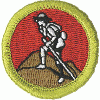 Scouting
Heritage
Scouting
Heritage
A change was made to requirement 4b, and the footnote to that note has been removed since any Scouts that visited the exhibit are now over 18. The changes to the requirement are as follows:
- Write or visit the National Scouting Museum in Irving, Texas*. Obtain information about this facility. Give a short report on what you think the role of this museum is in the Scouting program.
*If you visited the BSA's traveling tour, Adventure Base 100, in 2010, you may use that experience to fulfill requirement 4b.
 Sculpture
Sculpture
Changes were made to requirement 2a. The changes to the requirement are as follows:
- Model in clay a life-sized human head. Then sculpt in modeling clay (such as Plastine or Sculpey) or carve/rasp in wood or soft stone plaster, or use 3D modeling software to make a small-scale model of an animal or person. Explain to your counselor the method and tools you used to sculpt the figure.
 Soil
and Water Conservation
Soil
and Water Conservation
A new requirement 4e was added in 2017 after the release of the 2017 Boy Scout Requirements book but omitted from the text in the 2018 Boy Scout Requirements book.. The text is as follows:
- Explain what an aquifer is and why it can be important to communities.
Note that, in addition to this change, we have found a number of differences between the requirements in the Soil and Water Conservation merit badge pamphlet and the 2018 edition of Boy Scout Requirements. Click here to see those differences.
 Theater
Theater
Changes were made to requirements 1, 3, and 5, requirement 6 was deleted, and a footnote to requirement 1 was added. The changes to the requirements are as follows:
- See or read three full-length plays or scripts. These can be from the stage, movies, television, or video.* Write a review of each. Comment . Discuss with your counselor the plot or story. If you chose to watch the plays, comment on the story, acting, and the staging.
- Do Discuss with your counselor the safety precautions that should be practiced when working in a theater to protect the cast and crew.
Then do THREE of the following:
- Act a major part in a full-length play; or act a part in three one-act plays.
- Direct a play. Cast, rehearse, and stage it. The play must be at least 10 minutes long.
- Design the set for a play or a theatrical production of a circus. Make a model of it.
- Design the costumes for five characters in one play a theatrical production set in a historical time before 1900.
- Show skill in stage hair and makeup design. Make up yourself or a friend as an old man a historical figure, a clown, an extraterrestrial, or a monster as directed.
- With your counselor's approval, help Help with the building and painting of the scenery for one full-length play or two one-act plays a theatrical production.
- With your counselor's approval, design Design the lighting for a play; or, under guidance, handle help install, focus, color, program, and operate the lighting for a play theatrical production.
- With your counselor's approval, help install, focus, equalize, program, and operate the sound for a theatrical production.
- Serve as the stage manager for a theatrical production. Document all cues and stage setups in your calling script.
- Explain the following: proscenium arch, central or arena staging, spotlight, floodlight, flies, center stage, stage right, stage left, stage brace, downstage, upstage, stage crew, flies, portal, cyclorama, portal, stage brace, spotlight, floodlight, lighting control board, sound board mixing desk.
6. Do two short entertainment features that you could present either alone or with others for a troop meeting or campfire.*Watching plays on television, video, or as a movie is not permitted.
 Weather
Weather
Changes were made to requirement 10 by deleting the introduction and requirement 10b, and renumbering requirement 10a as requirement 10. The changes to the requirements are as follows:
- Do ONE of the following:
a. Give a talk of at least five minutes to a group (such as your unit or a Cub Scout pack) explaining the outdoor safety rules in the event of lightning, flash floods, and tornadoes. Before your talk, share your outline with your counselor for approval.
b. Read several articles about acid rain and give a prepared talk of at least five minutes about the articles to a group (such as your unit or a Cub Scout pack). Before your talk, share your outline with your counselor for approval.
 Wilderness
Survival
Wilderness
Survival
Changes were made to requirements 4, 9, and 11. The changes to the requirements are as follows:
- Describe the steps you would take to survive in the following exposure conditions:
- Cold and snowy
- Wet (forest)
- Hot and dry (desert)
- Windy (mountains or plains)
- At or on the water Water (ocean, lake, or river)
- Explain how to protect yourself from insects, reptiles, and bears, and other animals of the local region..
- Show that you know the proper clothing to wear while in your area on an overnight in in the outdoors during extremely hot weather and in extremely cold weather and during wet conditions.
Merit Badges with differences between
the current merit badge pamphlet
and the 2018 Boy Scout Requirements book
In the following discussions, text that appears in the Boy Scout Requirements book, which has been replaced or deleted in the merit badge pamphlet, is shown in red italic lettering, while the replacement or new text that appears in the merit badge pamphlets is shown in large Green lettering.
 Camping
Camping
The wording of requirement 9b1 in the Camping merit badge pamphlet is different than the wording in Boy Scout Requirements 2017 and 2018.
The wording of this requirement, as it appears in the 2016 edition of the Camping merit badge pamphlet is as follows:
- Hike up a mountain where, at some point, you are at least 1,000 feet higher in elevation from where you started.
The wording of this requirement, as it appears in the 2017 and 2018 editions of Boy Scout Requirements is as follows:
- Hike up a mountain, gaining at least 1,000 vertical feet.
 Fire
Safety
Fire
Safety
In the 2016 edition of the Fire Safety merit badge
pamphlet, what was formerly requirement 3 was renumbered as 3a, and the
text of a new requirement was added as 3b.
The changes adding this new requirement as they appear in the 2016 edition
of the Fire Safety merit badge pamphlet are as follows:
- Do the following:
- Name the most frequent causes of fire in the home and give examples of ways they can be prevented. Include a discussion about fires caused by smoking in the home, cooking, candles, fireplaces, and electrical appliances.
- Determine if smoke detectors are required in all dwellings within your municipality. If so, explain which specific types are required. Tell your counselor what type of smoke detectors your house has or needs.
- Choose a fire safety-related career that interests you and describe the level of education required and responsibilities of a person in that position. Tell why this position interests you.
In the 2017 and 2018 Boy Scout Requirements books,
the new text appears as requirement 12, and the previous requirement 12
is numbered as 13.
The changes to the requirements (as they appear in the Boy Scout Requirements
books) are as follows:
- Name the most frequent causes of fire in the home and give examples of ways they can be prevented. Include a discussion about fires caused by smoking in the home, cooking, candles, fireplaces, and electrical appliances.
- Determine if smoke detectors are required in all dwellings within your municipality. If so, explain which specific types are required. Tell your counselor what type of smoke detectors your house has or needs.
- 12. Choose a fire safety-related career that interests you and describe the level of education required and responsibilities of a person in that position. Tell why this position interests you.
 Fish
and Wildlife Management
Fish
and Wildlife Management
The last sentence of requirement 7c has read "You may visit ..." in the Fish and Wildlife Management merit badge pamphlet, and "You must visit ..." in the Boy Scout Requirements books since it was added in 2004.
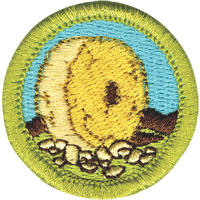 Inventing
Inventing
The wording of requirement 4 in the Inventing merit badge pamphlet is different than the wording in Boy Scout Requirements 2017 and 2018.
The wording of this requirement, as it appears in the 2016 edition of the Inventing merit badge pamphlet is as follows:
- Discuss with your counselor the types of inventions that are appropriate to share with others without protecting and explain why. Tell your counselor about one unpatented invention and its impact on society.
The wording of this requirement, as it appears in the 2017 and 2018 editions of Boy Scout Requirements is as follows:
- Discuss with your counselor the types of inventions that are appropriate to share with others without protecting and explain why. Tell your counselor about one nonpatented or noncopyrighted invention and its impact on society.
 Personal
Fitness
Personal
Fitness
When a new Personal Fitness merit badge pamphlet was issued in 2013, it contained information on a "Body Composition Evaluation" which was to replace the former "Body Composition Test", and new wording for requirements 6 and 8. Since then, the Boy Scout Requirements booklet has had different wording (unchanged from the earlier requirements) for requirements 6 and 8 than what appears in the merit badge pamphlet.
The wording of requirements 6 and 8 in the Personal Fitness merit badge pamphlet is as follows:
- Before doing requirements 7 and 8, complete the aerobic fitness, flexibility, and muscular strength tests, along with the body composition evaluation as described in the Personal Fitness merit badge pamphlet. Record your results and identify those areas where you feel you need to improve.
- Complete the physical fitness program you outlined in requirement 7. Keep a log of your fitness program activity (how long you exercised; how far you ran, swam, or biked; how many exercise repetitions you completed; your exercise heart rate; etc.). Repeat the aerobic fitness, muscular strength, and flexibility tests every two weeks and record your results. After the 12th week, repeat all of the required activities in each of the three test categories, record your results, and show improvement in each one. For the body composition evaluation, compare and analyze your preprogram and postprogram body composition measurements. Discuss the meaning and benefit of your experience, and describe your long-term plans regarding your personal fitness.
The wording of requirements 6 and 8 in the Boy Scout Requirements book is as follows:
- Before doing requirements 7 and 8, complete the aerobic fitness, flexibility, muscular strength, and body composition tests as described in the Personal Fitness merit badge pamphlet. Record your results and identify those areas where you feel you need to improve.
- Complete the physical fitness program you outlined in requirement 7. Keep a log of your fitness program activity (how long you exercised; how far you ran, swam, or biked; how many exercise repetitions you completed; your exercise heart rate; etc.). Repeat the aerobic fitness, muscular strength, and flexibility tests every two weeks and record your results. After the 12th week, repeat the three tests, record your results, and show improvement in each one. For the body composition test, compare and analyze your preprogram and postprogram body composition measurements. Discuss the meaning and benefit of your experience, and describe your long-term plans regarding your personal fitness.
The requirements for the Flexibility, Aerobic Fitness, and Strength tests and for the Body Composition Evaluation which involves a calculation of the BMI percentile, which are all specified in requirements 6 and 8, are defined in the current Personal Fitness merit badge pamphlet.
The Physical Fitness Tests specified for requirements 6 and 8 are as follows:
- Aerobic Fitness Test
Record your performance on one of the following tests:- Run/walk as far as you can as fast as you can in nine minutes
OR - Run/walk one mile as fast as you can
- Run/walk as far as you can as fast as you can in nine minutes
- Flexibility Test
Using a sit-and-reach box constructed according to specifications in this merit badge pamphlet, make four repetitions and record the fourth reach. This last reach must be held steady for 15 seconds to qualify. (Remember to keep your knees down.) - Strength Tests
You must do the sit-ups exercise and one other (either push-ups or pull-ups). You may also do all three for extra experience and benefit.- Sit-ups. Record the number of sit-ups done correctly in 60 seconds. The sit-ups must be done in the form explained and illustrated in the merit badge pamphlet.
- Pull-ups. Record the total number of pull-ups completed correctly in 60 seconds. Be consistent with the procedures presented in the merit badge pamphlet.
- Push-ups. Record the total number of push-ups completed correctly in 60 seconds. Be consistent with the procedures presented in the merit badge pamphlet.
Sit and Reach Box for the Flexibility
Test:
To see instructions for building the Sit and Reach Box,
Click here.
The illustration shows dimensions for constructing the reach box in inches,
while the requirement table in the pamphlet stipulates measuring the Scout's
reach in centimeters (cm). Either attach a tape measure calibrated in both
inches and cm to the top panel, or mark the top panel in cm. The measuring
scale should extend from 0 at the front edge of top panel to 53 cm at a
point 0.34 cm before the back edge. That should place the 23 cm point 0.14
cm behind the face of the foot panel.
Body Composition Evaluation (Calculating Your BMI):
- Step 1 - Multiply your weight in pounds by 703.
- Step 2 - Divide the figure you get in No. 1 above by your height in inches.
- Step 3 - Divide the figure you get in No. 2 above by your height in inches to get your BMI.
- Step 4 - Use the chart in the Personal Fitness merit badge pamphlet to determine the BMI percentile for your age.
As an example, if you are 15 years old, your weight is 130 pounds, and your height is 5'8" (68"), then:
- 130 x 703 = 91390
- 91390 / 68 = 1344
- 1344 / 68 = 20.
This means your BMI is 20. From the chart in the pamphlet, you are at the 50th percentile.
 Small
Boat Sailing
Small
Boat Sailing
There is an editorial error in the 2017 Boy Scout Requirements book, in requirement 1b. ("... while canoeing:" should read "... while sailing:") The correct wording appears in the Small-Boat Sailing merit badge pamphlet.
The wording of this requirement, as it appears in the 2016 edition of the Small-Boat Sailing merit badge pamphlet is as follows:
- Review prevention, symptoms, and first-aid treatment for the following injuries or illnesses that can occur while sailing: blisters, cold-water shock and hypothermia, dehydration, heat-related illnesses, sunburn, sprains, and strains.
The wording of this requirement, as it appears in the 2017 and 2018 editions of Boy Scout Requirements is as follows:
- Review prevention, symptoms, and first-aid treatment for the following injuries or illnesses that can occur while canoeing: blisters, cold-water shock and hypothermia, dehydration, heat-related illnesses, sunburn, sprains, and strains.
 Soil
and Water Conservation
Soil
and Water Conservation
A number of changes to the text of the requirements for this merit badge were first published in the Soil and Water Conservation merit badge pamphlet (#33291A) issued in 2004. The revised requirements were also included in the version of the pamphlet issued in 2008 (#35952) and in the 2010 revision of the 2004 edition (#35952 - SKU 610016) and each printing of each of those editions. However, the revised text was not included the 2005 edition of Boy Scout Requirements, nor in any of the subsequent editions of that booklet, up to and including the 2017 edition which have all included the older wording of the requirements.
What is shown below are the differences between the text as it has appeared in Boy Scout Requirements, and the text which has been used in the merit badge pamphlets.
Note that, in addition to these differences, a new requirement 4e was added in 2017 after the release of the 2017 Boy Scout Requirements book, but omitted from the 2018 Boy Scout Requirements book. Click here to see that change.
- Tell why it soil conservation is important. Tell how it affects you.
- Take pictures of or draw two kinds of soil erosion.
- Take pictures of or draw three kinds of erosion-control practices.
- Then outline on your map, Outline, as far as possible the map will allow, the next larger watershed which that also has the smallest smaller one in it.
- Explain what a river basin is. Tell why all people living in a river basin should be concerned about land and water use in it the basin.
- Show by demonstration Demonstrate at least two of the following actions of water in relation to the soil: percolation, capillary action, precipitation, evaporation, transpiration.
- Tell how uses of forest, range, and farm land farmland affect usable water supply.
- Seed an area of at least 1/5 one-fifth acre for some worthwhile conservation purpose purposes, using suitable grasses or legumes alone or in a mixture.
- Study a soil survey report. Describe the things in it. On Using tracing paper and pen, trace over any of the soil maps, and outline an area with three or more different kinds of soil. List each kind of soil by full name and map symbol.
 Traffic
Safety
Traffic
Safety
A new Traffic Safety merit badge pamphlet with revised requirements was issued in 2016. There were changes to requirements 5b and 5d which have not been made to the text in Boy Scout Requirements 2017 and 2018.
The wording of these requirements, as it appears in the 2016 edition of the Traffic Safety merit badge pamphlet is as follows:
- Using the Internet (with your parent's permission), visit five websites that cover safe driving for teenagers. Then in a group session with at least three teenagers and your counselor, discuss what you have learned..
- Accompanied by an adult and a buddy, pick a safe place to observe traffic at a controlled intersection (traffic signal or stop sign) on three separate days and at three different times of the day, for 30 minutes on each visit. At this intersection, survey violations that might occur. These violations could include (but are not limited to) running a red light or stop sign, speeding, using a cell phone while driving, or occupants not wearing their seat belts. Count the number of violations. Record in general terms the approximate age of the people you observed. Keep track of the total number of vehicles observed so that you can determine the percentage of compliance vs. violations. Discuss the findings with your merit badge counselor.
The wording of these requirements, as it appears in the 2017 and 2018 editions of Boy Scout Requirements is as follows:
- Using the Internet (with your parent's permission), visit five Web sites that cover safe driving for teenagers. As a group, discuss what you learn with your counselor and at least three other teenagers.
- Accompanied by an adult and a buddy, pick a safe place to observe traffic at a controlled intersection (traffic signal or stop sign) on three separate days and at three different times of the day, for 30 minutes on each visit. At this intersection, survey (1) such violations as running a red light or stop sign ; or (2) seat belt usage . Count the number of violations or number of drivers not wearing a seat belt. Record in general terms if the driver was young or old , male or female . Keep track of the total number of vehicles observed so that you can determine the percentage of compliance vs. violations. Discuss the findings with your merit badge counselor.
Special Opportunities
Discontinued Awards
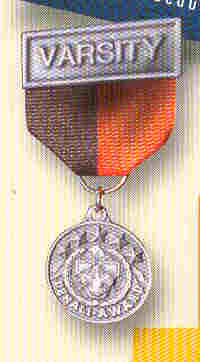 Denali
Award
Denali
Award
In conjunction with the end of the Varsity Scout program, The Denali Award is no longer available.
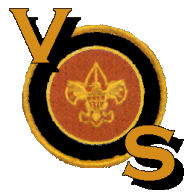 Varsity
Letters and Pins
Varsity
Letters and Pins
In conjunction with the end of the Varsity Scout program, The Varsity Letters and Pins are no longer available. This change was not noted in the listing on the inside front cover of the 2018 Boy Scout Requirements book.
New programs
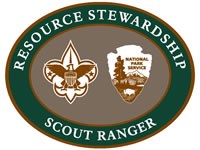 National
Park Service Resource Stewardship Scout Ranger
National
Park Service Resource Stewardship Scout Ranger
Information on this National Park Service program is now included in the Boy Scout Requirements book. Visit https://www.nps.gov/subjects/youthprograms/scout-ranger.htm for complete information.
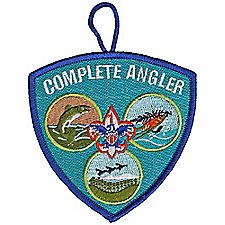 Complete
Angler Recognition
Complete
Angler Recognition
The Complete Angler recognition was established by the BSA's National Fishing Task Force in October 2014, to honor well-rounded youth anglers. This change was not noted in the listing on the inside front cover of the 2018 Boy Scout Requirements book. The requirements which are now included in the Boy Scout Requirements book, are as follows:
- Earn the three fishing-related merit badges: Fishing, Fly-Fishing, and Fish and Wildlife Management.
- Successfully complete one or more of the following projects:
- Teach a Fishing or Fly-Fishing merit badge skill to your troop or crew as part of a unit program activity.
- Help instruct Cub Scouts on fishing skills or fishery management as part of a Cub Scout meeting or outing.
- Participate in a local fishing derby or tournament, either a Scouting or community event.
- Complete a conservation project that will benefit a local fishery.
 Whitewater
Rafting BSA
Whitewater
Rafting BSA
Whitewater Rafting BSA was introduced at the 2017 National Jamboree and is now included in the Boy Scout Requirements book. This change was not noted in the listing on the inside front cover of the 2018 Boy Scout Requirements book. The requirements are as follows:
- Before doing the following requirements, successfully complete the BSA swimmers test.
- Do the following:
- Name the parts of a whitewater raft.
- Describe differences between a paddle raft and an oar powered raft.
- Explain the importance of perimeter lines used on whitewater rafts.
- Demonstrate how to choose an appropriate size paddle.
- Demonstrate how to select and properly fit a life jacket.
- Demonstrate how to select and properly fit a helmet.
- Discuss the use of throw ropes in rescuing overboard paddlers.
- Discuss common river hazards including rocks, strainers, broaching, standing waves, hydraulics and foot entrapment.
- Explain the importance of safety equipment used in whitewater rafting including throw ropes, helmets and life jackets. Also discuss appropriate clothing and footwear for a whitewater rafting trip.
- Under proper supervision and appropriate conditions safely do the following:
- Lift, carry, launch and land an inflatable raft, with help, on calm or slow moving water.
- Sit in a raft as a paddler with proper foot position.
- Swim a Class I rapid while wearing a life jacket, helmet and attire appropriate for the water temperature. Demonstrate defensive and aggressive swimming positions as possible.
- While on calm or slow moving water, demonstrate the following strokes in an inflatable raft with at least one other paddler and on command of a qualified paddle captain:
- Forward
- Back
- Sweep
- While on moving water up to Class I, demonstrate the following maneuvers with at least 3 other paddlers in an inflatable raft and on the command of a qualified paddle raft captain:
- Turn left
- Turn right
- Paddle forward in a straight line for 50 feet.
- Back paddle reasonably straight for 15 feet.
- While on moving water up to Class I, demonstrate the following maneuvers with at least 3 other paddlers in an inflatable raft and on the command of a qualified paddle raft captain:
- A front or a back ferry.
- A shallow or a wide eddy turn.
- A shallow or a wide peel out.
- Participate in a whitewater rafting trip in up to Class III whitewater with a qualified paddle raft captain in each raft using a minimum of two rafts and for at least one hour's duration.
Modified Requirements
 National
Outdoor Badges for Camping, Aquatics, Conservation, Hiking, Riding, and
Adventure
National
Outdoor Badges for Camping, Aquatics, Conservation, Hiking, Riding, and
Adventure
 National
Medal for Outdoor Achievement
National
Medal for Outdoor Achievement
In conjunction with the end of the Varsity Scout program, all references to the Varsity Scouting program have been deleted from the requirements for these awards. No other changes were made to the requirements for these awards. These changes were not noted in the listing on the inside front cover of the 2018 Boy Scout Requirements book.
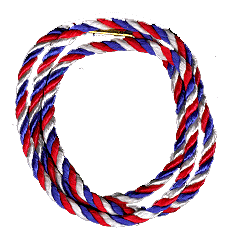 Den
Chief Service Award
Den
Chief Service Award
Requirements 2, 10, and 11h were revised. Also, in conjunction with the end of the Varsity Scout program, the references to the Varsity Scouting program should be deleted from the introduction shown below which only appears in the Den Chief Handbook These changes were not noted in the listing on the inside front cover of the 2018 Boy Scout Requirements book.. The revisions are as follows:
Before you begin work on this service award, discuss with your Den Leader and either your Scoutmaster, Varsity Scout Coach, Skipper, Venturing Adviser, or Cubmaster the role and importance of the Den Chief.
- Attend Den Chief Training (if available within year of service) OR be trained by the assistant Cubmaster and den leader.
Complete online Den Chief Training (or in person conducted by the council or district).- Meet as needed with the adult members of the den, pack, troop, team, ship, or crew.
- Recommend to your Scoutmaster, Varsity Scout Coach, Skipper, or Venturing Advisor another Boy Scout, Varsity Scout, Sea Scout, or Venturer to be a den chief.
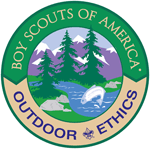 Outdoor Ethics Awareness Award
Outdoor Ethics Awareness Award
Requirements 2and 5 were revised. These changes were not noted in the listing on the inside front cover of the 2018 Boy Scout Requirements book. The revisions are as follows:
- Watch the National Park Service Leave No Trace video. It's on the right side of the page.
- Participate in an outdoor ethics course, workshop, or training activity facilitated by a person who has completed the BSA Leave No Trace 101 course or the BSA outdoor ethics orientation course or is OR by a BSA outdoor ethics trainer or master who has completed one of the following: the Leave No Trace Master Educator course, the Leave No Trace Trainer course, the Tread Lightly! Master Tread Trainer course, or the Tread Lightly! Tread Trainer course.
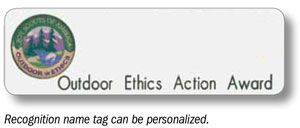 Outdoor Ethics Action Award
Outdoor Ethics Action Award
Requirements 1a, 1b, 2a, 3a, 3b, 4, and 6 were revised when the Application for BSA Lifeguard was revised in 2017. However, the changes were not included in the 2018 Boy Scout Requirements book. The revisions are as follows:
- Unless already completed, earn Earn the Outdoor Ethics Awareness Award.
- Complete the BSA outdoor ethics orientation or the BSA Leave No Trace 101 course.
- Read Chapter 7 of the Boy Scout Handbook on Leave No Trace outdoor ethics.
- Successfully complete a term as your troop Leave No Trace Trainer outdoor ethics guide, including reading the Outdoor Ethics Guide Handbook and carrying out a plan developed with the support of your advisor or Scoutmaster..
- Participate in Work with your troop's patrol leaders' council to plan an outing that emphasizes the complete set of Leave No Trace or relevant Tread Lightly! principles. All members of the troop participating in the outing should use the outdoor ethics and the specific practice the specific outdoor ethics skills needed to minimize impacts from their use of the outdoors.
- Follow the Outdoor Code, Leave No Trace, and Tread Lightly! principles on three outings. Write a paragraph on each outing one or more paragraphs about the three outings you attended, explaining how you followed the Outdoor Code, Leave No Trace, and Tread Lightly! Share it with your unit leader Discuss what you wrote with your unit leader, troop outdoor ethics guide, outdoor ethics guide advisor, or an individual who has completed the BSA outdoor ethics orientation Leave No Trace 101 course, the Leave No Trace Master Educator course, the Leave No Trace Trainer course, the Tread Lightly! Master Tread Trainer course, or the Tread Lightly! Tread Trainer course.
- Participate in a report at a court of honor or similar family event on the service activity in conducted to complete requirement 5.
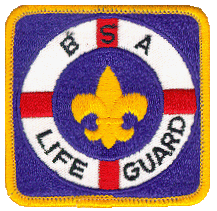 BSA Lifeguard
BSA Lifeguard
In 2017 a revised version of the Application for BSA Lifeguard was issued. That application included the following changes:
- Requirements 3, 5, and 6 were revised;
- New requirements 7 and 8 were added;
- Old requirements 7, 12, 13, and 20-23 were renumbered as 9, 14, 15, and 21-24;
- Od requirements 8-11 and 15-19 were revised and renumbered as 10-13 and 16-20; and
- Old requirements 14 and 24 were deleted.
In addition, items 1 and 5 of the BSA Lifeguard Training Procedure were revised.
These changes were not included in the 2018 Boy Scout Requirements book. The revised requirements and training procedure are as follows:
Prerequisites
- Submit proof of age. You must be at least 15 years old to participate.
- Submit written evidence of fitness for swimming activities (signed health history).
- Swim continuously for 550 yards including at least 100 yards each of the following strokes, in good form: using the front crawl, or breaststroke, elementary backstroke, and sidestroke or a combination of either, but swimming on the back or side is not allowed.
- Immediately following the above swim, tread water for two minutes using the legs only and with the hands under the armpits.
- Starting in the water, swim 20 yards using a front crawl or breaststroke, surface dive 7 to 10 feet, retrieve a 10-pound object, surface, swim on your back with the object 20 yards back to the starting point with both hands holding the object, and exit the water, all within 1 minute, 40 seconds.
Requirements
Complete the following requirements within a 120-day period:
- Show evidence of current training in American Red Cross First Aid and American Red Cross CPR/AED for the Professional Rescuer or equivalent (includes any training for a camp health officer recognized by BSA national camp standards).
- Show evidence of current training in the BSA online module for Safe Swim Defense.
- Attend and actively participate in all activities, presentations, and skill sessions involving lifeguard behavior, duties, responsibilities, surveillance, intervention and water rescue as prescribed in the BSA Lifeguard Instructor Manual.
- 7. Demonstrate reaching assists from the deck using an arm, a rescue tube, and a pole.
- 8. Demonstrate throwing assists using a throw bag and a ring buoy with a line attached. Throw each device such that the line lands within reach of a conscious an active subject 30 feet from shore.
- 9. Demonstrate:
- Rescue of a conscious an active in deep water using a rescue board, kayak, rowboat, canoe, or other rescue craft that would be available at your local facility.
- Repeat for an unconscious passive subject.
- 10. Demonstrate an entry and front approach with a rescue tube to a conscious an active subject in deep water 30 feet away from shore. Position the rescue tube to support the subject and then assist the subject to safety, providing direction and reassurance throughout.
- 11. Demonstrate an entry and rear approach with a rescue tube to a conscious an active subject in deep water 30 feet away from shore. Secure and support the subject from behind and then move the subject to safety, providing direction and reassurance throughout.
- 12. Demonstrate use of a rescue tube to assist two subjects grasping each other. Secure, support, and reassure both subjects. With the assistance of a second guard, calm and separate the subjects and move them to safety.
- 13. Demonstrate both front and rear head-hold escapes from a subject's grasp.
14. Demonstrate a feet-first entry in deep water with a rescue tube and swim an approach stroke 25 yards within 25 seconds while trailing the tube.- 15. Demonstrate an entry and front approach with a rescue tube to a face-down passive subject 30 feet away at or near the surface in deep water. Use a wrist roll to position the subject face-up on the rescue tube, tow them to safety, and remove them from the water with assistance within two minutes 90 seconds. Immediately perform a primary assessment and demonstrate one-person CPR for three minutes.
- 16. Demonstrate an entry and rear approach with a rescue tube to a face-down unconscious passive subject 30 feet away at or near the surface in deep water. Position the subject face-up, tow them to safety, and remove them from the water with assistance within two minutes. Immediately perform a primary assessment and demonstrate two-person CPR for three minutes.
- 17. Demonstrate In shallow water, demonstrate in-water ventilation of an unconscious subject when prompt removal from the water is not possible. Open the airway, position the mask, and simulate ventilations.
- 18. Demonstrate an entry and approach with a rescue tube for use when an unconscious a passive subject is submerged face-down at or near the bottom in 6 to 8 feet of water. Bring the subject to the surface and tow to the nearest point of safety.
- 19. Remove a subject from the water using each of the following techniques in the appropriate circumstances with the aid of a second rescuer:
- Vertical lift Extrication at the edge of a pool or pier using a backboard
- Walking assist
- Beach drag
- 20. Participate in multiple-rescuer search techniques appropriate for a missing subject in murky water:
- Line search in shallow water
- Underwater line search in deep water without equipment
- Underwater line search in deep water with mask and fins
- 21. Demonstrate in-line stabilization for a face-down subject with suspected spinal injury in very shallow water (18 inches or less).
- 22. Demonstrate in-line stabilization for a suspected spinal injury in shallow water (waist to chest deep):
- For a face-up subject
- For a face-down subject
- 23. Demonstrate in-line stabilization for a suspected spinal injury in deep water, swim the subject to shallow water, confirm vital signs, and with the assistance of three others, remove the subject from the water using a backboard with straps and a head immobilization device.
24. Demonstrate care for a spinal injury on land in the following situations:
- a. Non-standing subject
- b. Standing subject including securing to a backboard and lowering to the ground
- Correctly answer 80 percent of the questions on the BSA Lifeguard knowledge test covering the course material. Review any incomplete or incorrect answers.
- Serve as a lifeguard, under supervision, for at least two separate BSA swimming activities for a combined time of two hours. Afterward, discuss the experience with the lifeguarding instructor.
BSA LIFEGUARD TRAINING PROCEDURE
- Only those persons currently certified trained as BSA Aquatics Instructor or as BSA Lifeguard Counselor Instructor may train the completion of BSA Lifeguard requirements
- Training as BSA Lifeguard is valid for two years from the date of completion.
- All requirements must be met. (See completion options.)
- The completed application is forwarded to the local council service center, where the individual's training record is annotated.
- To qualify for BSA Lifeguard, the candidate must complete the BSA Lifeguard course under the direction of either a BSA Lifeguard Instructor or a BSA Aquatics Instructor. The course for the BSA Lifeguard is in the BSA Lifeguard Instructor Guide Manual.
Primary Source: 2018 Boy Scout Requirements
(33216 - SKU 641568)
Source for BSA Lifeguard Requirements:
Application for BSA Lifeguard (430-033WB - 2017 Revision)
This analysis was prepared as a service to Scouts and
Scouters nationwide
Paul S. Wolf
Secretary
US Scouting Service Project, Inc.
This document is a product of the U.S. Scouting Service Project, Inc. (USSSP). It may be reproduced by or for Scouting volunteers and used locally for training purposes consistent with the programs of the Boy Scouts of America (BSA), the World Organization of the Scout Movement (WOSM) or other Scouting and Guiding Organizations. However, it may not be used or reproduced for electronic redistribution or for commercial or other non-Scouting purposes without the express permission of the U. S. Scouting Service Project, Inc. (USSSP) or other copyright holders. The USSSP is not affiliated with BSA or WOSM and does not speak on behalf of BSA or WOSM. Opinions expressed in this document are those of the web authors.
Printed copies of this document may be freely distributed
for use in the Scouting program,
so long as the source is acknowledged, but copying the information to another
web site is NOT authorized.
A PDF version of this document can be found and downloaded by clicking here.
© 2018 - U.S. Scouting Service Project, Inc. - All Rights
Reserved
The text and images reproduced herein is © - Boy Scouts of America, and
is used by permission.







